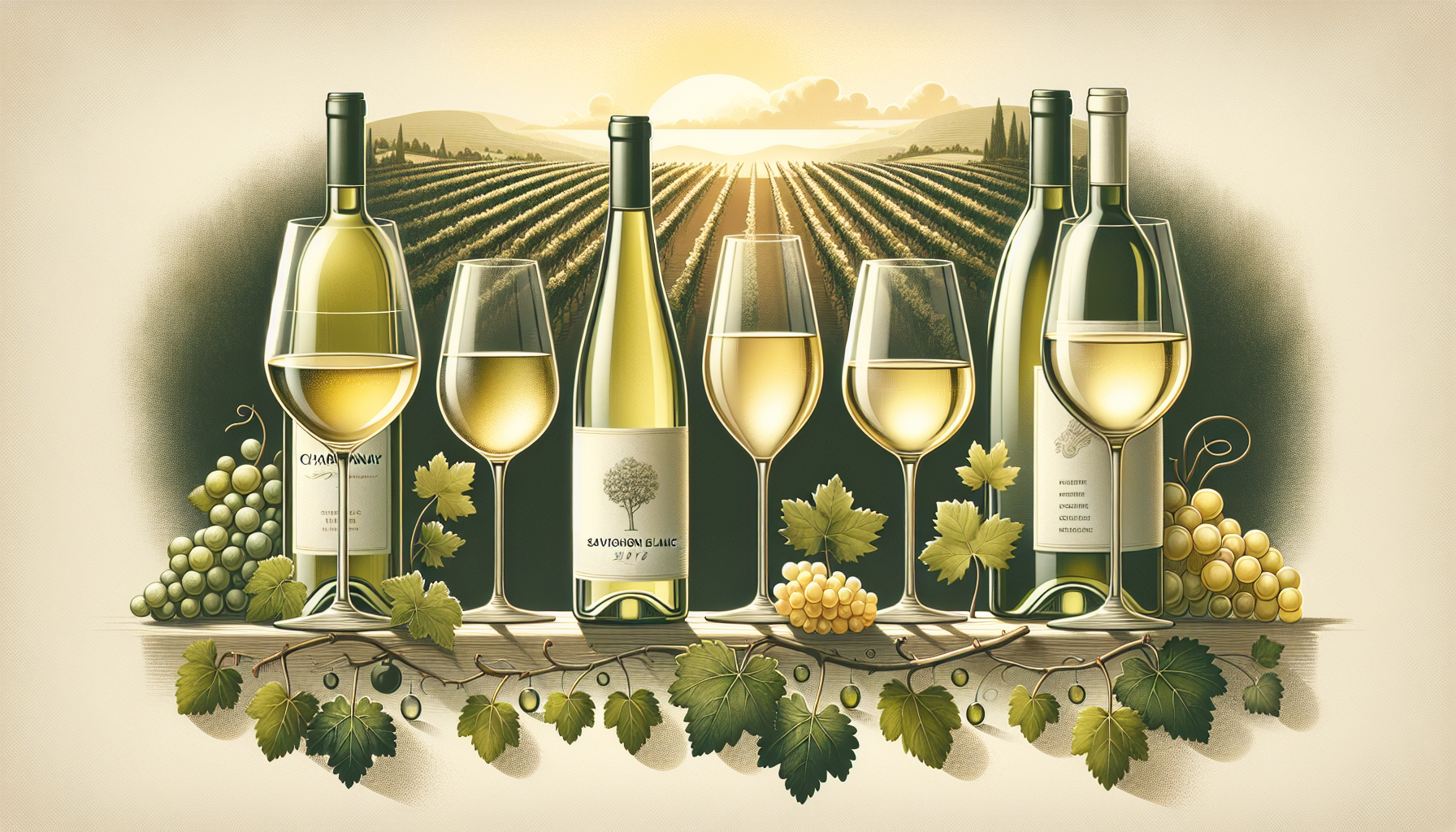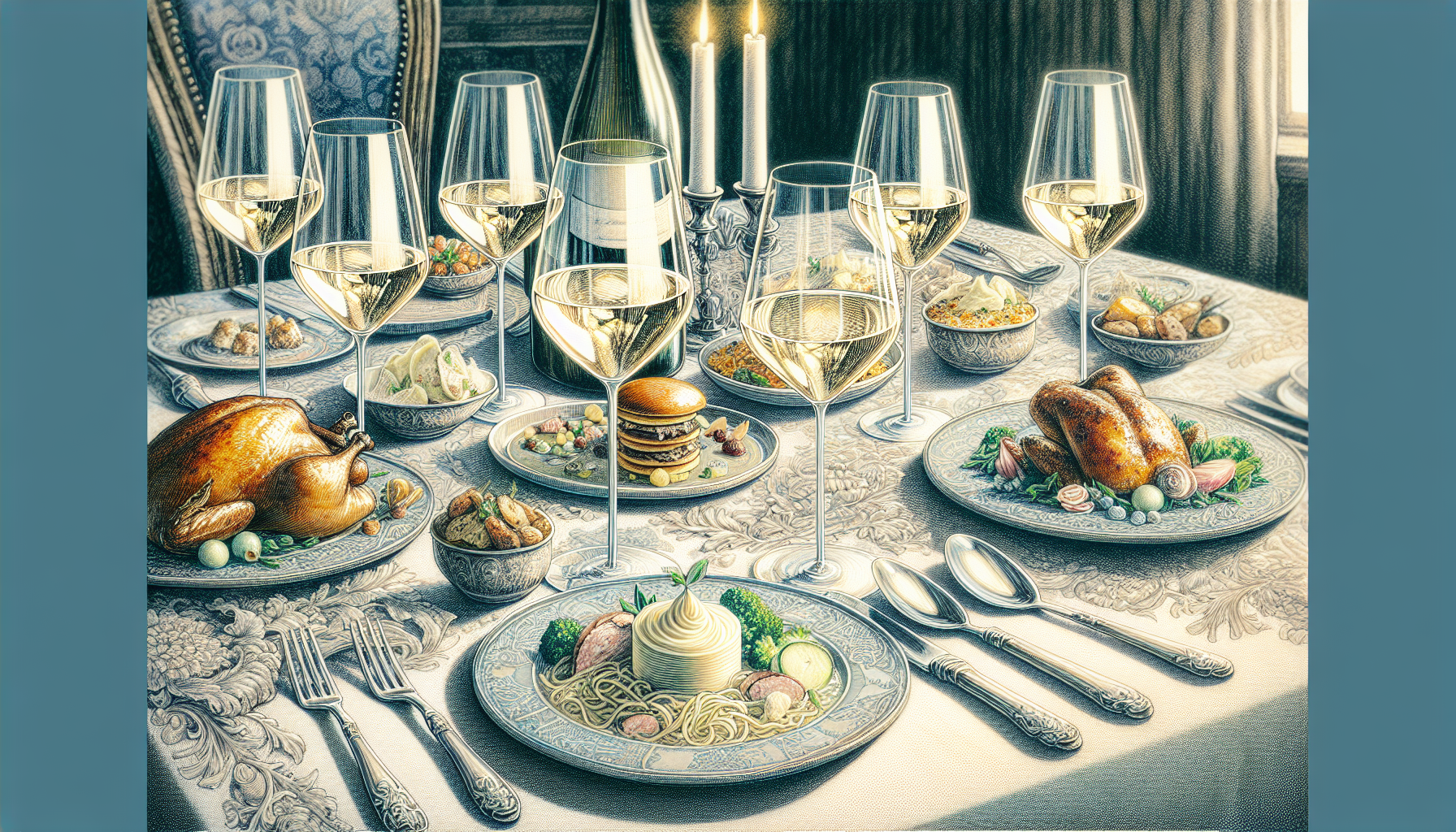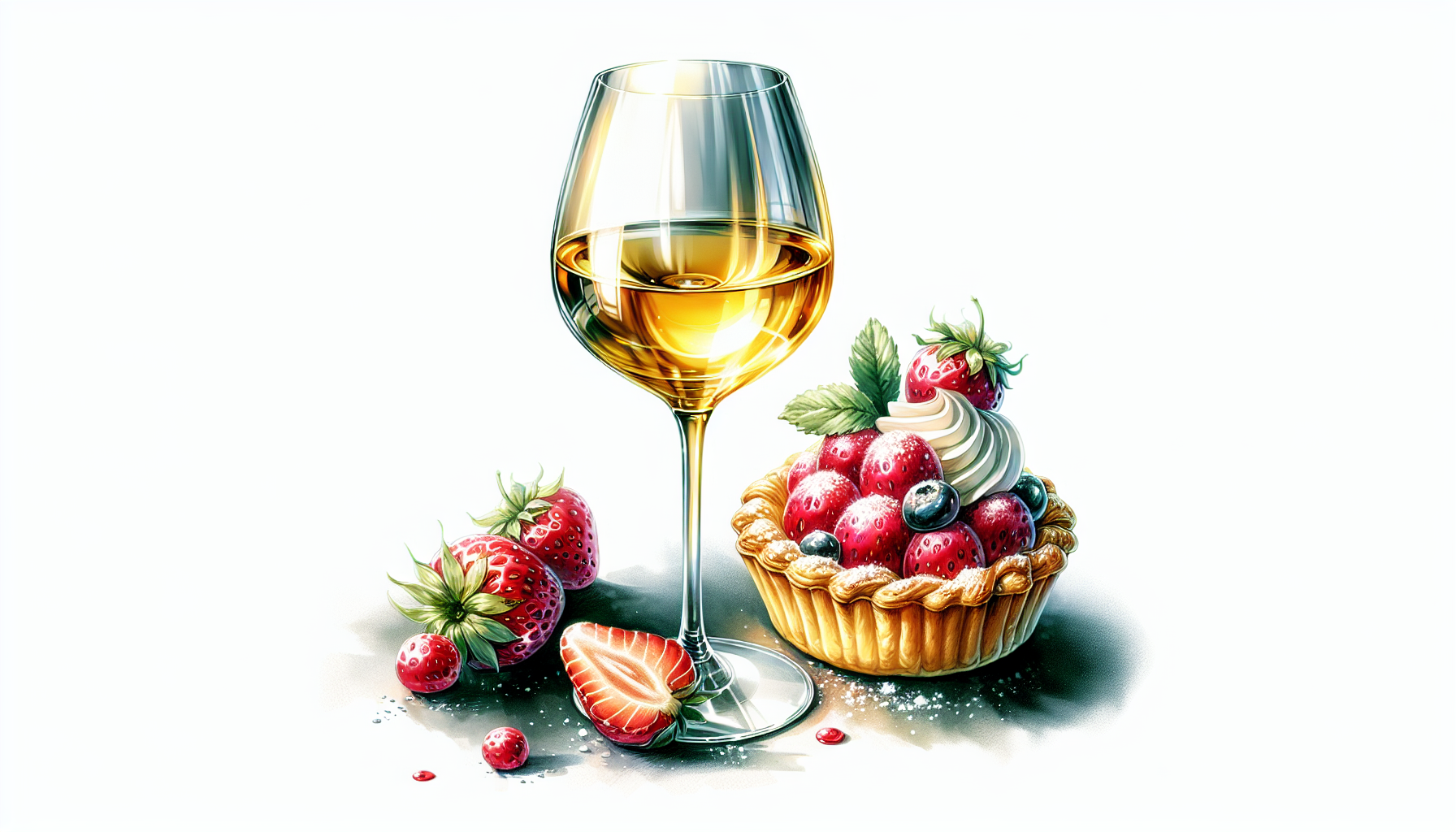Let's put the Cabernet Sauvignon aside for a moment and talk about the perfect white wine for any occasion.
White wine, made from white or dark grapes but without the skins, seeds, and stems, offers a light, refreshing taste. This article covers its unique features, popular types, ideal food pairings, and tips for choosing and serving.
Key Takeaways
- White wines vary greatly in flavor and body, with types like Sauvignon Blanc offering crisp, citrusy notes and oaked Chardonnay delivering rich, buttery flavors.
- Popular white wine varieties include Chardonnay, Sauvignon Blanc, Pinot Grigio/Pinot Gris, Riesling, and Chenin Blanc, each with unique characteristics and regional specialties.
- Proper storage and serving techniques, like maintaining a consistent temperature and serving at the right temperature, are essential to preserving and enhancing the flavors of white wine.
Understanding White Wine
hite wine, crafted from either white or dark grapes, has a unique fermentation process. The grape skin, seeds, and stems are removed prior to fermentation, leading to a lighter flavor profile than red wines.
White wines are fermented at lower temperatures, which gives them a refreshing floral and citrusy aroma, often reminiscent of citrus fruits. This presents a delightful contrast to the rich, tannin-heavy flavors found in red wines.
What makes white wine unique?
The beauty of white wine lies in its diversity. From the crisp, delicate notes of a Sauvignon Blanc to the rich, buttery flavors of an oaked Chardonnay, white wines offer a wide range of tasting experiences. This variety is further enhanced by the different grape varieties used, each bringing its own unique characteristics to the wine.
Key characteristics of white wines
White wines are characterized by their acidity, body, and flavor profiles. Light-bodied whites, like Pinot Grigio, are known for their delicate, refreshing qualities and low alcohol content. These wines often feature fruity to grassy aromas, making them perfect for a light, summery drink. Some examples of light-bodied white wines include:
- Pinot Grigio
- Sauvignon Blanc
- Riesling
- Albariño
- Vinho Verde
These wines are best served chilled and pair well with seafood, salads, and light pasta dishes.
Contrarily, full-bodied white wines like oaked Chardonnay possess a higher alcohol content and a richer texture, commonly influenced by oak barrels. These wines are packed with fruit flavors and can range from nutty to buttery, providing a more robust drinking experience.
Popular Varieties of White Wine

Several white wine varieties are notable for their popularity and distinct characteristics. We’ll delve into five primary types:
- Chardonnay
- Sauvignon Blanc
- Pinot Grigio/Pinot Gris
- Riesling
- Chenin Blanc
Chardonnay
Chardonnay is the world’s favorite white wine, known for its versatility and global cultivation. This grape can produce a wide range of flavors, from the citrusy and crisp unoaked Chardonnay to the creamy, buttery notes of oaked Chardonnay.
Regions like the Casablanca Valley in Chile are famous for their exceptional Chardonnay, benefiting from the cool climate influenced by the Pacific Ocean. Whether you prefer the bright acidity of an unoaked Chardonnay or the rich texture of an oaked one, Chardonnay offers something for everyone.
Sauvignon Blanc
Sauvignon Blanc is a highly aromatic, medium-bodied white wine, renowned for its distinctive green flavors and pronounced herbal notes. This wine often features flavors like gooseberry, honeydew, and grapefruit, with a refreshing citrus-led palate.
Notable regions for Sauvignon Blanc include the Loire Valley in France, which produces fresh and aromatic wines, and Marlborough in New Zealand, known for its vibrant and zesty expressions.
Pinot Grigio/Pinot Gris
Pinot Grigio and Pinot Gris are produced from the same grape but offer different experiences based on their growing regions. Pinot Grigio, typically associated with Italy, is known for its crisp, dry qualities, while French Pinot Gris tends to be sweeter and more aromatic.
Riesling
Riesling is celebrated for its high acidity and aromatic qualities, capable of producing wines that range from bone dry to highly sweet. Originating from the Rhine region in Germany, Riesling has gained popularity worldwide for its versatile styles and food pairing potential.
The Mosel region in Germany is particularly renowned for its Riesling wines, which are noted for their high acidity and slate-driven minerality. Whether enjoyed young or aged, Riesling offers a delightful drinking experience.
Chenin Blanc
Chenin Blanc is a highly versatile grape that can be used to produce a wide range of wine styles, from clean and crisp to sweet and even sparkling. This wine often features flavors of green apple, pear, honey, tropical fruits, and white peach, with aged varieties exhibiting nutty tones.
France’s Loire Valley and South Africa’s Stellenbosch region are recognized for their high-quality Chenin Blanc wines.
Food Pairing with White Wines

Skillfully pairing food with white wine enhances both the dish and the wine. Balancing the body and flavor intensity of the wine with the food is crucial. High-acid white wines such as Sauvignon Blanc and Riesling are excellent with fatty or salty foods, and full-bodied whites like Chardonnay pair well with richer, bolder flavors.
The Terroir Principle indicates that wines often pair best with foods from their specific region of origin. For instance, a California Chardonnay beautifully complements local Californian cuisine.
Light-bodied whites
Light-bodied white wines, such as Pinot Grigio, are ideal for pairing with seafood, chicken, and salads. These delicate and refreshing wines enhance the flavors of lighter dishes without overpowering them.
Medium-bodied whites
Medium-bodied white wines, like Chardonnay and Viognier, offer versatility and can complement a variety of foods. These wines are perfect for dishes with moderate richness and complexity.
Full-bodied whites
Full-bodied white wines, such as oaked Chardonnay and aged Viognier, are known for their rich texture and bold flavors, making them excellent companions for hearty dishes. Oaked Chardonnay, for example, pairs exceptionally well with creamy and buttery lobster dishes.
These wines also enhance the flavors of hearty fish or seafood in rich sauces, making them a great choice for formal occasions.
Sweet White Wines and Dessert Wines

Sweet white wines, typically served as dessert wines, are recognized for their lower acidity and higher sugar content. Muscat and Riesling are frequently used to craft these sweet gems, making them the perfect choice for those seeking a sweet white wine experience.
Types of sweet white wines
Some popular sweet wines and sparkling wines include:
- Moscato d’Asti: light, bubbly character and floral aroma
- Sauternes: made primarily from Semillon grapes, renowned for its rich sweetness
- Riesling Ice Wine: produced in colder climates, high sugar content and vibrant acidity.
Naturally sweet dessert wines, like those served with lemon curd, often involve a detailed process where grapes infected with Botrytis cinerea fungus concentrate their sugars, leading to a rich, sweet wine reminiscent of tropical fruit flavors.
Pairing sweet wines with desserts
Sweet wines like Moscato d’Asti are particularly well-suited for fruit-based desserts, enhancing their natural sweetness. Pairing sweet wines with desserts can create a delightful culinary experience, making both the wine and dessert shine.
Sweet vs. dry white wines
The primary difference between sweet and dry white wines is the level of sweetness perceived due to sugar content. Dry white wines have higher acidity and no sweetness, offering a cleaner and crisper taste compared to the noticeably sweeter sweet wines.
White Wines from Around the World
umerous regions worldwide produce white wines, each uniquely expressing their local terroir.
Let’s explore some of these regions and their celebrated white wines.
French white wines
France boasts some of the most prestigious white wines, including Sancerre and Chablis. Sancerre, made from 100% Sauvignon Blanc, and Chablis, made from 100% Chardonnay, share near-identical qualities due to their proximity and similar climates. Chablis is exclusively a white wine, while Sancerre also produces rosé and red wines from Pinot Noir.
Italian white wines
Italy presents a diverse array of white wines from regions such as Friuli-Venezia Giulia and Piedmont. Some notable white wines from these regions include:
- Pinot Grigio
- Ribolla Gialla
- Malvasia Istriana
- Cortese
- Arneis
- Moscato
- Erbaluce
New World white wines
New World regions like California’s Napa Valley are famous for high-quality Chardonnay, Sauvignon Blanc, and Viognier. Chardonnay, in particular, is grown globally but is most prominently found in France, Australia, and California.
Choosing the Right White Wine
Choosing the appropriate white wine requires comprehending wine labels and aligning the wine with the occasion. Information about the producer, region, and vintage can offer valuable insights into the wine’s quality and character.
Reading wine labels
Wine labels reveal significant information about the wine, including the vintage year, alcohol content, and grape variety. These details can help you choose a wine that matches your taste preferences and the occasion.
Matching wine to occasion
Choosing the right white wine often depends on the event you are hosting or attending, as well as the meal being served. For a casual gathering, a crisp Sauvignon Blanc or a light Pinot Grigio can be perfect. For more formal occasions or dinners, a full-bodied Chardonnay or a versatile Chenin Blanc might be more suitable.
Personal taste and preferences play a crucial role in this selection. Don’t hesitate to ask questions, look for award-winning wines, or consider wines from regions with climates similar to your favorites. Chenin Blanc, with its wide range of styles, is an excellent choice for various events and meals.
Storing and Serving White Wine
Adopting proper storage and serving techniques is fundamental for preserving the quality of white wine and augmenting its flavors. Storing your wine appropriately and serving it at the perfect temperature can markedly improve your wine experience.
Proper storage techniques
White wine should be stored at a consistent temperature between 50-55°F (10-13°C) to maintain its quality over time. Storing wine bottles on their sides keeps the cork moist and prevents air from leaking in, which can spoil the wine.
Additionally, a cool, dark place is ideal for storage.
Serving tips
To enhance the flavors and aromas of white wine, serve it at a temperature between 45-50 degrees Fahrenheit. Light-bodied white wines like Sauvignon Blanc should be served around 45°F. Place the wine in the fridge for about an hour before serving to achieve the optimal temperature.
Summary
White wines offer a diverse range of flavors and styles, making them suitable for any occasion. From the crisp and refreshing Sauvignon Blanc to the rich and buttery oaked Chardonnay, there’s a white wine for every palate and event. Understanding the key characteristics, popular varieties, and proper pairing techniques can enhance your wine experience.
Whether you’re hosting a dinner party, enjoying a casual meal, or exploring new wine regions, knowing how to choose, store, and serve white wine will make your experience more enjoyable. Cheers to discovering the perfect white wine for every occasion!
Frequently Asked Questions
What makes white wine unique compared to red wine?
White wine is unique compared to red wine because it is made without the skins, seeds, and stems, resulting in a lighter flavor profile and lower tannin concentration. So, it's generally more crisp and refreshing!
What are the main types of white wine?
The main types of white wine are Chardonnay, Sauvignon Blanc, Pinot Grigio/Pinot Gris, Riesling, and Chenin Blanc. Each type has its own unique characteristics and flavors. Cheers!
Where can I buy white wine for a sangria?
Whether you're looking for a white wine for a sangria recipe or a house-warming gift, we've got you covered. At FineWineHouse, we have a wide selection or red, white, and sparkling wine. And that's not all. We have liquor and beer, too. Contact us with any questions.
How should I store white wine?
Store your white wine at a consistent temperature between 50-55°F in a cool, dark place. Keep the bottles on their sides to keep the cork moist.
What foods pair well with light-bodied white wines?
Light-bodied white wines like Pinot Grigio go great with seafood, grilled chicken, and fresh salads, making them taste even better. Enjoy!

